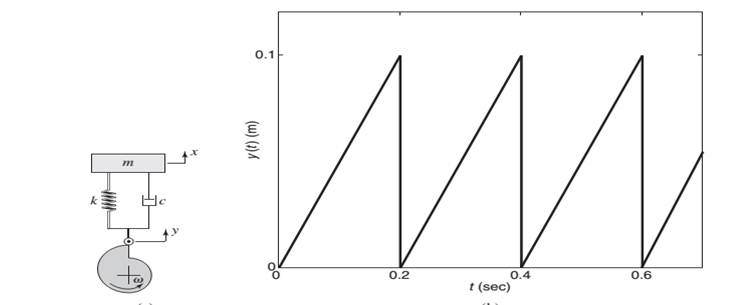
The expression for the steady state displacement x(t)for a cam.
The steady stat response for the given Fourier series is given by

Given:
The displacement produced by the cam is given by the following figure

Figure 1 Figure 2
Where m = 1 Kg,  and k = 4900N/m.
and k = 4900N/m.
Fourier series approximation = 
Concept Used:
We first derive an expression for transfer function of the given system and then calculate  magnitude of the given transfer function, phase angle, bandwidth, and magnitude of phase angles of respective frequencies, and finally calculate the expression for steady state response.
magnitude of the given transfer function, phase angle, bandwidth, and magnitude of phase angles of respective frequencies, and finally calculate the expression for steady state response.
Calculation:
Fourier series approximation = 
From Figure 1 equation of motion is given by,
 (1)
(1)
Substituting for m = 1 Kg,  and k = 4900N/m in equation (1)
and k = 4900N/m in equation (1)

Applying Laplace transform for the above equation



The transfer function for the given system
T(s)  (2)
(2)

Therefore magnitude of above transfer function is given by
 (3)
(3)
The phase angle is given by
 (4)
(4)
From the equation (3) we can observe that  attains a peak of 1 when
attains a peak of 1 when  0. Hence
0. Hence  = 0 and
= 0 and  is calculated as follows
is calculated as follows


Squaring on both sides we get,






On further simplification we get

The roots of the equation are 
Taking only the positive value 
 143.42 rad/s
143.42 rad/s
Therefore, the bandwidth lies between 0 and 143.42 rad/s that is 
As  is greater than 143.42 rad/s which is outside the required bandwidth, we consider only 0, 10
is greater than 143.42 rad/s which is outside the required bandwidth, we consider only 0, 10  20
20  30
30  and 40
and 40  for frequency values.
for frequency values.
From equation (3) 
Substituting for  0, 10
0, 10  20
20  30
30  and 40
and 40  respectively we get
respectively we get

 .... (5)
.... (5)

 =
= 
 =1.015
=1.015



 1.263
1.263



 1.038
1.038



 0.806
0.806
From equation (4) we have 
Now calculating the phase angles for corresponding frequencies  0, 10
0, 10  20
20  30
30  and 40
and 40  respectively we get,
respectively we get,

 rad
rad







 2.247 rad
2.247 rad

 2.038 rad
2.038 rad
The steady state response for the given Fourier series


Substituting the values of  and
and  for corresponding frequencies
for corresponding frequencies  0, 10
0, 10  20
20  30
30  and 40
and 40  respectively we get,
respectively we get,



Conclusion:
Therefore, the steady stat response for the given function is given by

Answer to Problem 9.33P
The steady stat response for the given Fourier series is given by

Explanation of Solution
Given:
The displacement produced by the cam is given by the following figure

Figure 1 Figure 2
Where m = 1 Kg,  and k = 4900N/m.
and k = 4900N/m.
Fourier series approximation = 
Concept Used:
We first derive an expression for transfer function of the given system and then calculate  magnitude of the given transfer function, phase angle, bandwidth, and magnitude of phase angles of respective frequencies, and finally calculate the expression for steady state response.
magnitude of the given transfer function, phase angle, bandwidth, and magnitude of phase angles of respective frequencies, and finally calculate the expression for steady state response.
Calculation:
Fourier series approximation = 
From Figure 1 equation of motion is given by,
 (1)
(1)
Substituting for m = 1 Kg,  and k = 4900N/m in equation (1)
and k = 4900N/m in equation (1)

Applying Laplace transform for the above equation



The transfer function for the given system
T(s)  (2)
(2)

Therefore magnitude of above transfer function is given by
 (3)
(3)
The phase angle is given by
 (4)
(4)
From the equation (3) we can observe that  attains a peak of 1 when
attains a peak of 1 when  0. Hence
0. Hence  = 0 and
= 0 and  is calculated as follows
is calculated as follows


Squaring on both sides we get,






On further simplification we get

The roots of the equation are 
Taking only the positive value 
 143.42 rad/s
143.42 rad/s
Therefore, the bandwidth lies between 0 and 143.42 rad/s that is 
As  is greater than 143.42 rad/s which is outside the required bandwidth, we consider only 0, 10
is greater than 143.42 rad/s which is outside the required bandwidth, we consider only 0, 10  20
20  30
30  and 40
and 40  for frequency values.
for frequency values.
From equation (3) 
Substituting for  0, 10
0, 10  20
20  30
30  and 40
and 40  respectively we get
respectively we get

 .... (5)
.... (5)

 =
= 
 =1.015
=1.015



 1.263
1.263



 1.038
1.038



 0.806
0.806
From equation (4) we have 
Now calculating the phase angles for corresponding frequencies  0, 10
0, 10  20
20  30
30  and 40
and 40  respectively we get,
respectively we get,

 rad
rad







 2.247 rad
2.247 rad

 2.038 rad
2.038 rad
The steady state response for the given Fourier series


Substituting the values of  and
and  for corresponding frequencies
for corresponding frequencies  0, 10
0, 10  20
20  30
30  and 40
and 40  respectively we get,
respectively we get,



Conclusion:
Therefore, the steady stat response for the given function is given by

Want to see more full solutions like this?
Chapter 9 Solutions
System Dynamics
- ### Superheated steam powers a steam turbine for the production of electrical energy. The steam expands in the turbine and at an intermediate expansion pressure (0.1 Mpa) a fraction is extracted for a regeneration process in a surface regenerator. The turbine has an isentropic efficiency of 90% Design the simplified power plant schematic Analyze it on the basis of the attached figure Determine the power generated and the thermal efficiency of the plant ### Dados in the attached imagesarrow_forwardThe machine below forms metal plates through the application of force. Two toggles (ABC and DEF) transfer forces from the central hydraulic cylinder (H) to the plates that will be formed. The toggles then push bar G to the right, which then presses a plate (p) into the cavity, thus shaping it. In this case, the plate becomes a section of a sphere. If the hydraulic cylinder can produce a maximum force of F = 10 kN, then what is the maximum P value (i.e. Pmax) that can be applied to the plate when θ = 35°? Also, what are the compressive forces in the toggle rods in that situation? Finally, what happens to Pmax and the forces in the rods as θ decreases in magnitude?arrow_forwardDetermine the magnitude of the minimum force P needed to prevent the 20 kg uniform rod AB from sliding. The contact surface at A is smooth, whereas the coefficient of static friction between the rod and the floor is μs = 0.3.arrow_forward
- Determine the magnitudes of the reactions at the fixed support at A.arrow_forwardLet Hill frame H = {i-hat_r, i-hat_θ, i-hat_h} be the orbit frame of the LMO satellite. These base vectors are generally defined as:i-hat_r = r_LM / |r_LM|, i-hat_theta = i-hat_h X i-hat_r, i-hat_h = r_LM X r-dot_LMO /( | r_LM X r-dot_LMO | ) How would you: • Determine an analytic expressions for [HN]arrow_forwardDe Moivre’s Theoremarrow_forward
- hand-written solutions only, please.arrow_forwardDetermine the shear flow qqq for the given profile when the shear forces acting at the torsional center are Qy=30Q_y = 30Qy=30 kN and Qz=20Q_z = 20Qz=20 kN. Also, calculate qmaxq_{\max}qmax and τmax\tau_{\max}τmax. Given:Iy=10.5×106I_y = 10.5 \times 10^6Iy=10.5×106 mm4^44,Iz=20.8×106I_z = 20.8 \times 10^6Iz=20.8×106 mm4^44,Iyz=6×106I_{yz} = 6 \times 10^6Iyz=6×106 mm4^44. Additional parameters:αy=0.5714\alpha_y = 0.5714αy=0.5714,αz=0.2885\alpha_z = 0.2885αz=0.2885,γ=1.1974\gamma = 1.1974γ=1.1974. (Check hint: τmax\tau_{\max}τmax should be approximately 30 MPa.)arrow_forwardhand-written solutions only, please.arrow_forward
- In the bending of a U-profile beam, the load path passes through the torsional center C, causing a moment of 25 kNm at the cross-section under consideration. Additionally, the beam is subjected to an axial tensile force of 100 kN at the centroid. Determine the maximum absolute normal stress.(Check hint: approximately 350 MPa, but where?)arrow_forward### Make an introduction to a report of a rocket study project, in the OpenRocket software, where the project consists of the simulation of single-stage and two-stage rockets, estimating the values of the exhaust velocities of the engines used, as well as obtaining the graphs of "altitude", "mass ratio x t", "thrust x t" and "ψ × t".arrow_forwardA 6305 ball bearing is subjected to a steady 5000-N radial load and a 2000-N thrust load and uses a very clean lubricant throughout its life. If the inner race angular velocity is 500 rpm find The equivalent radial load the L10 life and the L50 lifearrow_forward
 Elements Of ElectromagneticsMechanical EngineeringISBN:9780190698614Author:Sadiku, Matthew N. O.Publisher:Oxford University Press
Elements Of ElectromagneticsMechanical EngineeringISBN:9780190698614Author:Sadiku, Matthew N. O.Publisher:Oxford University Press Mechanics of Materials (10th Edition)Mechanical EngineeringISBN:9780134319650Author:Russell C. HibbelerPublisher:PEARSON
Mechanics of Materials (10th Edition)Mechanical EngineeringISBN:9780134319650Author:Russell C. HibbelerPublisher:PEARSON Thermodynamics: An Engineering ApproachMechanical EngineeringISBN:9781259822674Author:Yunus A. Cengel Dr., Michael A. BolesPublisher:McGraw-Hill Education
Thermodynamics: An Engineering ApproachMechanical EngineeringISBN:9781259822674Author:Yunus A. Cengel Dr., Michael A. BolesPublisher:McGraw-Hill Education Control Systems EngineeringMechanical EngineeringISBN:9781118170519Author:Norman S. NisePublisher:WILEY
Control Systems EngineeringMechanical EngineeringISBN:9781118170519Author:Norman S. NisePublisher:WILEY Mechanics of Materials (MindTap Course List)Mechanical EngineeringISBN:9781337093347Author:Barry J. Goodno, James M. GerePublisher:Cengage Learning
Mechanics of Materials (MindTap Course List)Mechanical EngineeringISBN:9781337093347Author:Barry J. Goodno, James M. GerePublisher:Cengage Learning Engineering Mechanics: StaticsMechanical EngineeringISBN:9781118807330Author:James L. Meriam, L. G. Kraige, J. N. BoltonPublisher:WILEY
Engineering Mechanics: StaticsMechanical EngineeringISBN:9781118807330Author:James L. Meriam, L. G. Kraige, J. N. BoltonPublisher:WILEY





